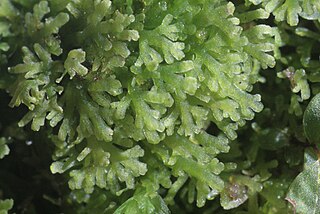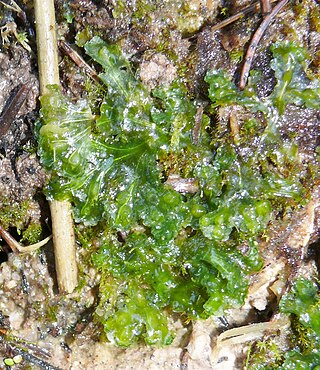
The Marchantiophyta are a division of non-vascular land plants commonly referred to as hepatics or liverworts. Like mosses and hornworts, they have a gametophyte-dominant life cycle, in which cells of the plant carry only a single set of genetic information.

Hornworts are a group of non-vascular Embryophytes constituting the division Anthocerotophyta. The common name refers to the elongated horn-like structure, which is the sporophyte. As in mosses and liverworts, hornworts have a gametophyte-dominant life cycle, in which cells of the plant carry only a single set of genetic information; the flattened, green plant body of a hornwort is the gametophyte stage of the plant.

Marchantiales is an order of thallose liverworts that includes species like Marchantia polymorpha, a widespread plant often found beside rivers, and Lunularia cruciata, a common and often troublesome weed in moist, temperate gardens and greenhouses.

Lunularia is a genus of liverworts whose only species is Lunularia cruciata, the crescent-cup liverwort. Lunularia is either the only genus in the order Lunulariales, or may be placed in the order Marchantiales. The name, from Latin luna, moon, refers to the moon-shaped gemma cups.

Jungermanniales is the largest order of liverworts. They are distinctive among the liverworts for having thin leaf-like flaps on either side of the stem. Most other liverworts are thalloid, with no leaves. Due to their dorsiventral organization and scale-like, overlapping leaves, the Jungermanniales are sometimes called "scale-mosses".

Metzgeriales is an order of liverworts. The group is sometimes called the simple thalloid liverworts: "thalloid" because the members lack structures resembling stems or leaves, and "simple" because their tissues are thin and relatively undifferentiated. All species in the order have a small gametophyte stage and a smaller, relatively short-lived, spore-bearing stage. Although these plants are almost entirely restricted to regions with high humidity or readily available moisture, the group as a whole is widely distributed, and occurs on every continent except Antarctica.

Jungermanniopsida is the largest of three classes within the division Marchantiophyta (liverworts).

Lepidoziaceae is a family of leafy liverworts. It is a group of small plants that are widely distributed.

Cavicularia densa is the only species in the liverwort genus Cavicularia. The species was first described in 1897 by Franz Stephani, and is endemic to Japan, where it grows on fine moist soil.

Blasiaceae is a family of liverworts with only two species: Blasia pusilla and Cavicularia densa. The family has traditionally been classified among the Metzgeriales, but molecular cladistics suggests a placement at the base of the Marchantiopsida.

Haplomitriopsida is a newly recognized class of liverworts comprising fifteen species in three genera. Recent cladistic analyses of nuclear, mitochondrial, and plastid gene sequences place this monophyletic group as the basal sister group to all other liverworts. The group thus provides a unique insight into the early evolution of liverworts in particular and of land plants in general.

Blasiales is an order of liverworts with a single living family and two species. The order has traditionally been classified among the Metzgeriales, but molecular cladistics suggests a placement at the base of the Marchantiopsida.

Marchantia polymorpha is a species of large thalloid liverwort in the class Marchantiopsida. M. polymorpha is highly variable in appearance and contains several subspecies. This species is dioicous, having separate male and female plants. M. polymorpha has a wide distribution and is found worldwide. Common names include common liverwort or umbrella liverwort.

Riella is a genus in the liverwort family Riellaceae, and includes about eighteen species. Plants in the genus are small and grow submerged in shallow temporary pools. Although the genus is widely distributed in the Northern Hemisphere, locating populations is often difficult. Its occurrence is sporadic and local, and the tiny plants are ephemeral. The ornamented spores remain viable for several years, allowing the plants to survive annual drying of their habitat. The plants are easily grown in laboratory cultures.

Acrobolbaceae is liverwort family in the order Jungermanniales.

Cephaloziaceae is a family of liverworts.

Pallaviciniales is an order of liverworts.

Solenostoma is a genus of liverworts belonging to the family Solenostomataceae.

Monoclea forsteri is one of the two species in the thallose liverwort family Monocleaceae. It is dioicous with the capsule dehiscing with a single longitudinal slit. Endemic and widely distributed throughout New Zealand, it is also the country's largest thalloid liverwort. Hooker described the species in 1820. The holotype is in the British Museum.



















